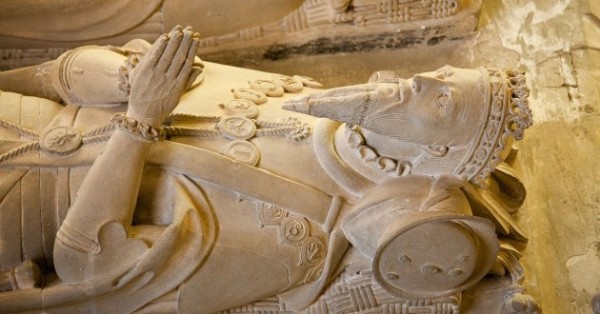Welcome to the Project! For me, as director, its origins go back to the 1980s when I worked with the eminent sculpture conservator Carol Galvin, at the Victoria and Albert Museum, on the relationship between the V&A’s terracotta bust of Henry VII by the Italian sculptor Pietro Torrigiano, and the funeral effigy of the king at Westminster Abbey. Peter Scott of UCL’s Photogrammetry Department used a Reflex Plotter to assist us in comparing the three-dimensional outlines of the portrait heads (Burlington Magazine, cxxx (1988), 892-902).
In the 1990s, I saw the development of 3D laser scanning, which represented a great technological leap forwards, at the National Museum and Galleries on Merseyside and was interested in applying the technology to other art-historical problems. The opportunity presented itself in 2006 when I was asked to assess sculptural and architectural fragments stored in an English Heritage warehouse in East Anglia. They had been preserved from large-scale excavations on the site of the ruins of Thetford Priory in the 1930s. Many pieces were known to be related to two of the tombs of the Howard family in Framlingham parish church, about 40 miles from Thetford (from the publications of Sir Howard Colvin & Professor Lawrence Stone; Professor Richard Marks; and my own investigation, published in 1997).
Framlingham had become the burial place of the Howards after Thetford Priory’s dissolution by Henry VIII. Exactly how these fragments related to the tombs, though, is controversial. We know that the tombs, commemorating Thomas Howard, third duke of Norfolk (1473-1554), and his son-in-law, Henry VIII’s illegitimate son, Henry Fitzroy, Duke of Richmond (1519- 1536), were almost complete by 1539 and were salvaged at some time in the 1550s and moved to Framlingham.
What had happened to the monuments between 1540, when the priory was dissolved, and their removal to Framlingham, almost certainly in the 1550s, has been unclear. The third duke tried, and failed, to preserve the priory, hoping to turn it into a collegiate or parish church. At the end of Henry VIII’s reign, he and his son, the Earl of Surrey had been arrested, and Surrey was executed on trumped-up charges. Though the duke survived (because of Henry VIII’s death) in January 1547, he spent Edward VI’s reign (1547-1553) in prison and was only released when Mary I came to the throne in 1553. An elderly man, he died in August 1554.
The tombs as erected at Framlingham are not what they appear: Professor Marks has shown that they were put together from salvaged components and finished off with new materials. Determining exactly what is original and what was added is difficult. Our research offers a radical new approach to the problem. By using 3-D scanning and analytical techniques developed in Leicester’s Space Research Centre, we shall ‘disassemble’ the tombs into their constituent parts, and recombine their components virtually, to try to recreate their original appearance before they were moved. So, we aim to recreate the first, lost, stages in the existence of the tombs. Our scientific investigation and analysis will determine which (if any) of the fragments excavated at Thetford originally belonged to these monuments and enable us to reintegrate, virtually, the appropriate fragments into our reconstructions.
Amongst the boxes of excavated fragments are many pieces from other important tombs which have never been discussed before. There are also fragments of free-standing images and of other sculptural ensembles, including a fragment of a roundel by the great Italian sculptor Giovanni da Maiano, directly related to his roundels at Hampton Court Palace for Cardinal Wolsey. Discovering this was one of the highlights of my first day’s visit to the warehouse! We shall use the same techniques to try recreate these other lost monuments and sculptures, and bring them back to (virtual) life. We will also investigate the paint surviving on some of the fragments: the roundel piece, for example still has its original paintwork, whereas the roundels at Hampton Court palace, to which it is directly related, have lost theirs. The fragment, then, provides critical evidence to help us understand how the Hampton Court roundels once appeared. Many of the other pieces of sculpture are very puzzling and I am using the website to seek your advice: perhaps you will have the keys to some of the problems we face. See the “Help us” section for them.
Through the funding from the Science and Heritage programme, we have been able to assemble this collaborative project combining research tools from space science, art history, archaeology, museology and computer science. By an utterly amazing chance, when I was visiting Yale University on a Fellowship in 2009, I found that Dr Lisa Ford, of the Yale Center for British Art, was working on the Earl of Surrey’s retrospective tomb also at Framlingham, and gratefully accepted her offer to work with us! As a collaborative team, working with English Heritage and the Norfolk Museums service, we aim to effect an important change in understanding of the late middle ages and Tudor Renaissance in England. The Howards were the most important noble family under Henry VIII and their fortunes provide a fascinating case study into a turbulent period in our national history. I hope that this gripping episode, and the detective story of its reconstruction, will prove fascinating to you, our audience.


